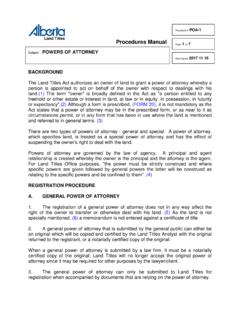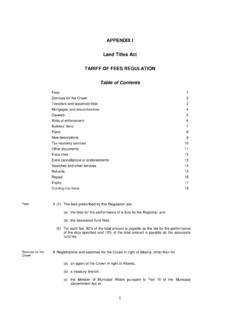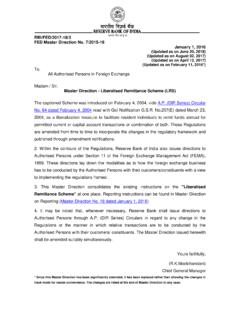Transcription of Land Titles & Surveys Procedures Manual
1 BACKGROUND Caveat" is a Latin word meaning "let him beware". The form used in the Torrens system is unknown at common law and "is a statutory notice of a claim of an interest in land that has been brought under the Land Titles Act". (1) It is a warning to anyone searching the certificate of title that the caveator is claiming an interest in that parcel of land. The interest claimed may or may not be a valid interest in the land but if its validity is disputed and upheld by the courts, any person dealing with the land subsequent to the registration of the caveat is subject to the interest claimed.
2 The comments of Duff, J. in Alexander v. McKillop & Benjafield (2) illustrate the function of the caveat in a Land Titles system: "The fundamental principle of the system of conveyancing established by this and like enactments is that title to land and interests in land is to depend upon registration by a public officer and not upon the effect of transactions inter partes. The act at the same time recognizes unregistered rights respecting land, confirms the jurisdiction of the courts in respect of such rights and furthermore makes provision - by the machinery of the caveat - for protecting such rights without resort to the courts.
3 This machinery, however, was designed for the protection of rights and not for the creation of rights. A caveat prevents any disposition of his title by the registered proprietor in derogation of the caveator's claim until that claim has been satisfied or disposed of; but the caveator's claim must stand or fall on its own merits." Registration by way of a caveat, whether by the Registrar or by any caveator, has the same effect as to priority as the registration of any instrument under the Land Titles Act. A caveator, or transferee of a caveat in whose name the caveat is registered, is included in the definition of owner in section 203(1)(b)(iii) of the Land Titles Act dealing with the protection of persons accepting transfer, etc.
4 (3) A caveat must be in substantial compliance with the requirements of the Land Titles Act to be valid. It should at least identify the land and state the claim with reasonable clarity. (4) The claim must be of an interest in land. There is no statutory provision to amend a caveat. Subject: CAVEATS Procedures Manual Procedure # CAV-1 Page 1 of 10 Date Issued 2021 01 01 Land Titles & Surveys REGISTRATION PROCEDURE 1. A person claiming to be interested in land for which a certificate of title has been issued or in a mortgage or encumbrance relating to that land a) pursuant to (i) a will, settlement or trust deed, (ii) an instrument of transfer or transmission, (iii) an unregistered instrument b) by virtue of the provisions of any Act of Alberta under which that person acquired any right with respect to that land, mortgage or encumbrance or c) by virtue of (i) having acquired through the owner or any prior owner, otherwise than under items a) or b)
5 , an interest in that land, mortgage or encumbrance after the first certificate of title was issued for that land, (ii) being the owner or previous owner of an interest in that land otherwise than under items a) or b), when that interest arose after the first certificate of title was issued for that land, or (iii) being the owner or a previous owner of the mortgage or encumbrance, otherwise than under items a) or b), may file a caveat in the prescribed form (5) (FORM 26) against the registration of any person as transferee or owner of, or any instrument affecting, the estate or interest, unless the certificate of title is expressed to be subject to the claim of the caveator.
6 2. Caveator a) The name of the person who is claiming an interest in the land is required. A "person" includes a corporation (6) but not a partnership or trade name as neither is a person at law as required by section 130. Corporate caveators must comply with section 27. b) Where a person is claiming an interest "as agent for" or "on behalf of" or "as receiver and manager of" a disclosed principal, the principal is the caveator. In the case of a receiver and manager this information should be entered in document particulars.
7 C) Where a person is claiming an interest as trustee in bankruptcy of a disclosed principal and the bankruptcy endorsement is not registered on the title, then the principal is the caveator. The bankruptcy trustee must be entered in document particulars. d) A caveat cannot be filed on behalf of an undisclosed principal. (7) If it is not clear from the caveat who is claiming the interest, the caveat should be rejected for clarification. 3. Nature of Interest Claimed - Both the nature of the interest claimed and the grounds on which the claim is founded must be stated for a caveat to be registrable.
8 (8) For example, a person who has entered into a binding contract to buy land would claim to have an interest as purchaser or beneficial owner ( , the nature of the interest) pursuant to an agreement for sale between the person and the registered owner ( , the grounds on which the claim is founded). Date Issued 2021 01 01 Page 2 of 10 Procedure # CAV-1 The document creating the interest claimed may be attached to the caveat but the nature of the interest must be ascertainable from the information in the caveat.
9 If no interest in land is being claimed or if the interest cannot be determined sufficiently, the caveat should be rejected. The responsibility to ensure that the nature of the interest being claimed is sufficiently stated in the caveat lies with the registrant. The reference to certain formations or zones on mineral caveats must be in the claim and not the legal description. If the formation or zone area is mentioned in the legal description, documents must be rejected. (Similarly there must be no reference to formations or zones in partial discharges or transfers of caveats).
10 4. Acceptable Interests for Caveats The following list represents common types of acceptable interests: Note: Items a) through f) must specify an amount (amounts and clarifications can be taken from attachment). a) equitable mortgagee or encumbrancee pursuant to an unregistered mortgage, debenture, encumbrance or floating charge (9) b) equitable mortgagee pursuant to a hypothecation agreement c) charge for real estate commission pursuant to a listing agreement which expressly charges the land (10) d) charge against the land pursuant to an agreement or statutory provision ( , unpaid condominium fees) e) equitable mortgagee pursuant to a mortgage of a mortgage f) security under the Bank Act g)














